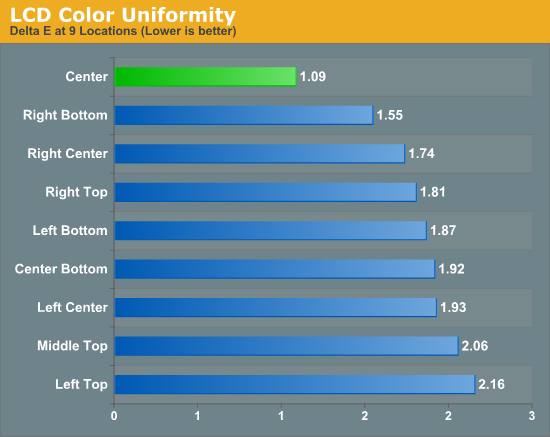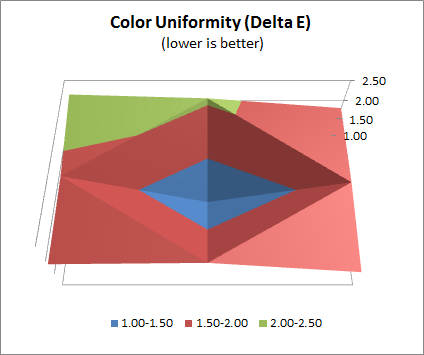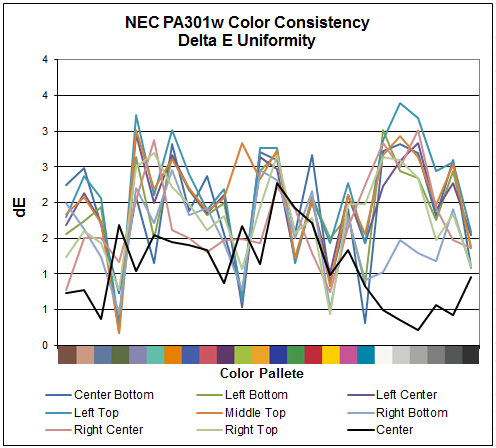NEC PA301w: The Baddest 30-inch Display Around
by Brian Klug on March 1, 2011 8:00 AM ESTColor Consistency
Now for color consistency, we take our best calibration profile from the very center at 200 nits and test color accuracy at 9 different places around the LCD display in an evenly distributed grid. We’ve shown before that calibration is actually very localized across the display, partly due to the brightness not being uniform, partly due to the discrete nature of the LCD panel itself.


If you go back and compare to the other 30-inchers, you'll discover that the PA301w is narrowly edges out the HP ZR30w and has a clear advantage over the Dell U3011. Interestingly enough, the PA301w has a uniformity setting inside the OSD which defaults to 5 (maximum) and seems to definitely improve overall brightness uniformity and Delta-E consistency. Whatever secret sauce NEC has apparently works.











92 Comments
View All Comments
mbaroud - Tuesday, March 1, 2011 - link
When i saw the title, i thought, wow, this must be a really bad monitor.After reading the review, it looks like it is THE BEST with except of weight and dimensions.
Could you please change title, its misleading.
LTG - Tuesday, March 1, 2011 - link
It's an American coloquialism instantly recognized by most who lived there whole lives here.That said, there is a lot of word play in journalism I don't get and is a little frustrating when it happens to me so I understand your point.
Mumrik - Tuesday, March 1, 2011 - link
Ever heard of "The Baddest Man of the Planet"?This is a very normal way to put it. Nothing wrong with the title.
Zoomer - Friday, March 18, 2011 - link
Given the international audience anandtech serves, he has a point.Soulkeeper - Tuesday, March 1, 2011 - link
CCFL Backlight165 watts (typical)
41.5 lbs (18.8 kg)
2560 x 1600 at 60 Hz
Might as well just get a 21" CRT with those specs and price ...
Nentor - Tuesday, March 1, 2011 - link
I am sitting in front of a 21" CRT that I am still reluctant to pass on (Sony GDM F520) and those weigh around 35 kg / 77 lbs. It can only do 2048x max.DanNeely - Tuesday, March 1, 2011 - link
We had this discussion on one of the previous 30" monitor reviews. While LEDs backlights are lower power than CCFLs and have won most of the mobile market, and while LEDs can surpass the gamut and color accuracy of midrange CCFLs at an acceptable price premium and are winning the consumer display market, the best RGB LED backlights still cannot beat the gamut and color accuracy of the best CCFL backlights. Until that happens (or until consumer demand becomes large enough to sell a less capable low power model) displays aimed directly at the professional market will continue to use CCFL backlighting despite the higher power consumption.The final point I'd make is that the "typical" power consumption NEC lists is a worst case number. Depending on brightnesss Brian measured 58-136 watts, and like most modern LCDs the maximum brightness levels are too high to use comfortably outside of an exceptionally bright area (because otherwise they'd be too dim in places), so you won't be running it at maximum brightness unless you're working outside in the desert.
Breit - Tuesday, March 1, 2011 - link
Not exactly right i guess. Every now and then there are some good RGB LED monitors in the news (at least on paper)... e.g. the LaCie 730 (http://www.lacie.com/products/product.htm?pid=1109... I don't know for sure if its any good 'cause i only have a poor Dell U3011 on my desk, but who knows?! ;)AnnonymousCoward - Tuesday, March 1, 2011 - link
I'll pass going into detail about how insane you are.Griswold - Wednesday, March 2, 2011 - link
You should have passed the test for "Professional display equipment 101" instead.